
¡Hola, amigos! Para nadie es un secreto que los embalsamadores de Egipto hicieron un trabajo maravilloso y tan eficiente, que han logrado que los cuerpos de sus personajes más célebres duraran miles de años, pero ¿alguna vez te has preguntado cómo fue el proceso de momificación? ¿Qué ingredientes, herramientas o elementos usaban? ¿Había alguna ceremonia? Si este tema te resulta interesante, sigue leyendo y verás que pasarás un buen rato.
Hi friends! It's no secret to anyone that the embalmers of Egypt did a wonderful and efficient job that they have made the bodies of their most famous characters last for thousands of years, but have you ever wondered what the mummification process was like? What ingredients, tools, or items did they use? Was there a ceremony? If this topic is interesting to you, keep reading and you will see that you will have a good time.

Los antiguos egipcios creían que la vida no terminaba con la muerte física, sino que continuaba en un mundo paralelo, sin embargo, para que la persona que acababa de fallecer continuara su existencia en la tierra, era necesario llevar a cabo un proceso muy importante. Ellos creían que el Ba, como solían llamarle al alma, volvería a la tierra para reencontrarse con el cuerpo del fallecido, por esta razón debía estar lo mejor conservado posible, y esto solo podía lograrse con la momificación.
The ancient epigcios believed that life didn't end with physical death, but continued in a parallel world, however, for the person who had just died to continue his existence on earth, it was necessary to carry out a very important process. They believed that the Ba, as they used to call the soul, would return to earth to be reunited with the body of the deceased, for this reason it should be as well preserved as possible, and this could only be achieved with mummification.
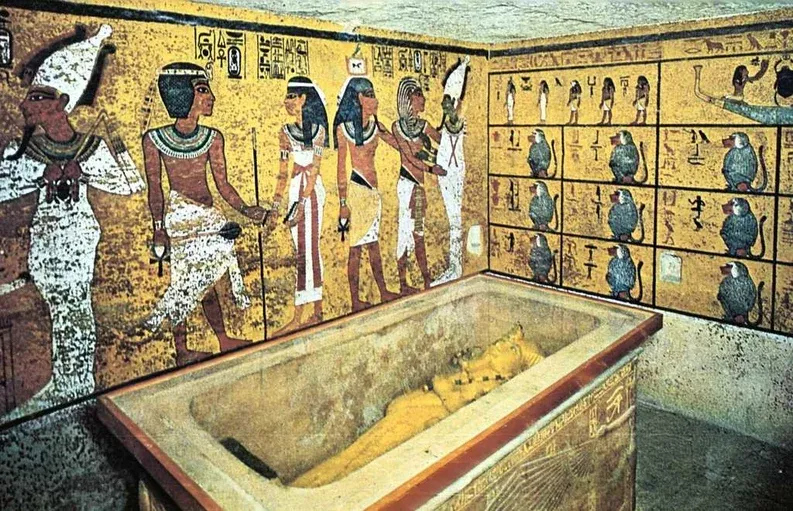
Según sus creencias, cuando una persona moría, comenzaba una travesía por el inframundo, también llamado Duat, y en su largo camino sería guiado por Anubis, dios con cabeza de chacal (por esta razón siempre se encontrarán imágenes de este dios en las tumbas egipcias) Al final del recorrido se encontraría con Osiris que sería el encargado de determinar su destino a través de un juicio.
According to their beliefs, when a person died, they began a journey through the underworld, also called Duat, and on their long journey they would be guided by Anubis, god with the head of a jackal (for this reason images of this god will always be found in Egyptian tombs ) At the end of the tour, he would meet Osiris who would be in charge of determining his fate through a judgment .
El juicio de Osiris/The judgment of Osiris
Osiris sacaba el corazón a los difuntos y luego lo colocaba sobre uno de los platos de una balanza, mientras que en el otro ponía una pluma de avestruz, que representaba a la diosa Maat (deidad de la justicia)
Osiris took out the heart of the deceased and then placed it on one of the plates of a balance while in the other he placed an ostrich feather, which represented the goddess Maat (deity of justice)
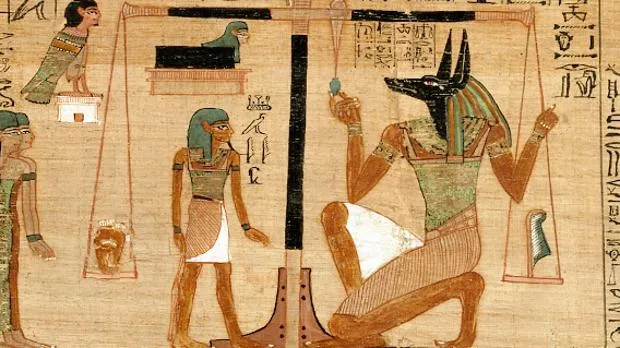
En este momento, el jurado presente en la sala de juicios iba haciendo ciertas preguntas al difunto, que él debía contestar siempre con la verdad. Si era una persona justa, con cada respuesta que daba, su corazón se hacía más ligero que la pluma, y por tanto se había ganado el derecho a vivir nuevamente, de modo que en algún punto regresaría a su cuerpo (que debía estar incorrupto) pero, si la persona era malvada, su corazón se haría más pesado que la pluma en la balanza, y por lo tanto estaría condenado a sufrir «una segunda muerte» es decir, que la diosa Ammit se comería su corazón.
At this moment, the jury present in the courtroom was asking the deceased certain questions that he must always answer truthfully. If he was a fair person, with each answer he gave, his heart became lighter than the feather, and therefore he had earned the right to live again, so that at some point he would return to his body (which must be uncorrupted) but, if the person was evil, his heart would become heavier than the feather on the balance, and therefore he would be condemned to suffer "a second death" that is, the goddess Ammit would eat his heart.
Mientras esto estaba ocurriendo, Thot, el dios de la sabiduría estaba junto a la balanza, escribiendo sobre una tablilla todo lo acontecido en la sala de juicios.
While this was happening, Thot, the god of wisdom was standing beside the balance, writing on a tablet everything that happened in the courtroom.
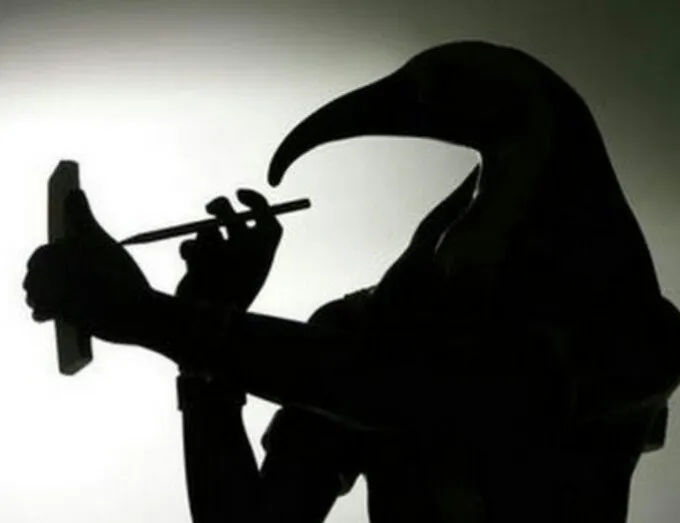

Momificación/Mummification
Mientras tanto en la tierra, en primer lugar se lavaba el cuerpo con agua del Nilo Occidental y posteriormente se trasladaba al Per-Nefer, es decir, el lugar sagrado donde se llevaría a cabo el proceso.
Meanwhile on earth, first, the body was washed with water from the West Nile and later it was transferred to Per-Nefer, that is, the sacred place where the process would take place.
Mientras trabajaba, uno de los embalsamadores, el sacerdote, llevaba puesta una sagrada máscara del dios Anubis (el que guía los pasos de la persona fallecida).
While working, one of the embalmers, the priest, wore a holy mask of the god Anubis (the one who guides the steps of the deceased person).
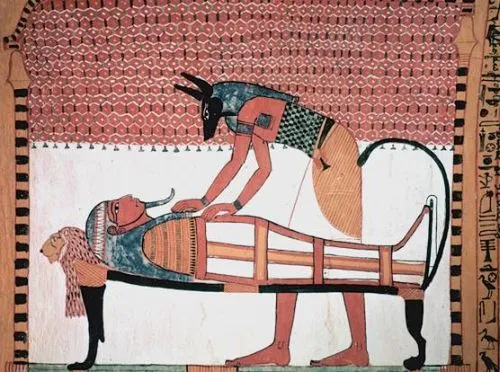
Los embalsamadores debían ser muy hábiles y asegurarse de trabajar rápido en el proceso de retirar los órganos del cuerpo, debido a que éstos tienen gran cantidad de agua y podrían comenzar a pudrirse. El primer órgano que se retiraba era el cerebro, porque es el que contiene más agua.
The embalmers had to be very skilled and make sure to work quickly in the process of removing the organs from the body, as these have a lot of water and could start to rot. The first organ to be removed was the brain, because it's the one that contains the most amount of water.
Usaban un gancho para retirar el cerebro y lo hacían a través de una de las fosas nasales.
They used a hook to remove the brain and did it through one of the nostrils.
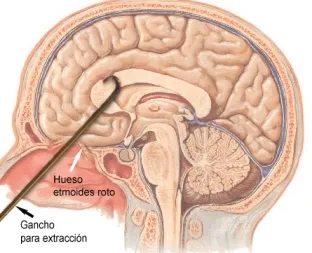
El espacio vacío en el cráneo era rellenado con paja y otros materiales.
The empty space in the skull was filled with straw and other materials.
Después se hacía un corte en el costado izquierdo con una cuchilla de obsidiana, que era una piedra sagrada, y se extraían todos los órganos, los cuales se lavaban con sumo cuidado, se untaban con aceites, se cubrían con resinas, se vendaban con lino y posteriormente eran depositados en los cuatro vasos canopos, que son recipientes funerarios que representan a una deidad diferente.
Afterwards, a cut was made in the left side with an obsidian blade, which was a sacred stone, and all the organs were extracted, which were washed with great care, smeared with oils, covered with resins, bandaged with linen and later they were deposited in the four canopic vessels, which are funerary vessels that represent a different deity.
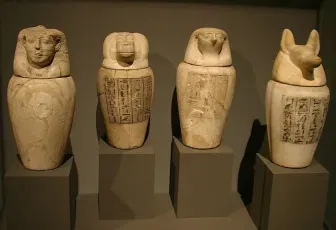
La vasija con cabeza humana se llama Amset y su función es la de contener el hígado, la que tiene cabeza de Papión (una clase de mono) se llama Hapy y contenía los pulmones, la que tiene cabeza de halcón recibe el nombre de Kebeshenuef, su función era la de resguardar los intestinos, y finalmente la vasija con cabeza de chacal (en representación a Anubis) contenía el estómago del muerto.
The vessel with a human head is called Amset and its function is to contain the liver, the one with the head of a Baboon (a kind of monkey) is called Hapy and contained the lungs, the one with the head of a hawk is called Kebeshenuef, its function was to protect the intestines, and finally the jackal-headed vessel (representing Anubis) contained the stomach of the dead.
El corazón era el único órgano que permanecía dentro de los cadáveres, ya que Osiris lo necesitaría para ponerlo en la balanza en el juicio.
The heart was the only organ that remained inside the corpses, since Osiris would need it to put it in the balance in the judgment.
Luego de este proceso, el cuerpo era llevado a un recipiente donde se cubría con polvo de natrón, un mineral de color blanco que actualmente se usa en la fabricación de vidrio, jabones y tintes. En ese entonces su función era la de absorber la humedad restante, secando los tejidos. Allí descansaba el cuerpo de treinta a cuarenta días. Pasado ese tiempo, se retiraba el cuerpo del natrón, se cosían las incisiones, se cubría con resina y ya estaba listo para el vendaje.
After this process, the body was taken to an container where it was covered with natron powder, a white mineral that is currently used in the manufacture of glass, soaps and dyes, at that time its function was to absorb the remaining moisture, drying the fabrics. There the body rested for thirty to forty days. After that time, the body was removed from the natron, the incisions were sewn, covered with resin, and it was ready for the bandage.
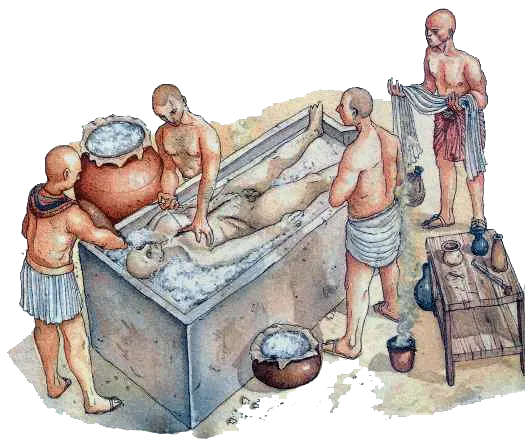
El vendaje/The Bandage
Llegados a este punto, los familiares del muerto debían tener preparados 372 metros cuadrados de tiras de lino. Los embalsamadores comenzaban el proceso en las manos y pies, posteriormente la cabeza, los brazos, las piernas y de último el torso. Es en este momento donde ellos colocaban un símbolo muy importante sobre el pecho del fallecido, la imagen de un escarabajo al que llamaban «escarabajo del corazón» y su función era la de evitar que el corazón del difunto lo traicionara en el momento del juicio.
At this point, the relatives of the deceased should have prepared 372 square meters of linen strips. The embalmers began the process in the hands and feet, later the head, arms, legs and lastly the torso. It is at this time that they place a very important symbol on the chest of the deceased, the image of a beetle that they called "heart beetle" and its function was to prevent the deceased's heart from betraying it at the time of the trial.
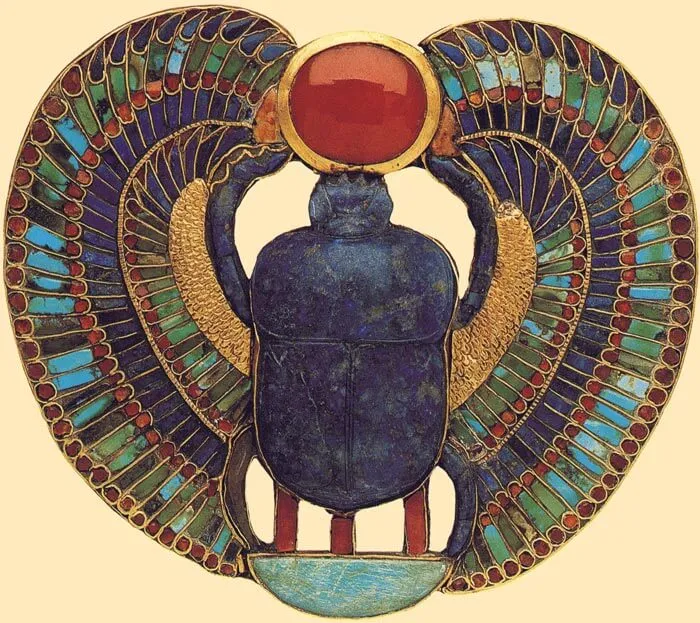
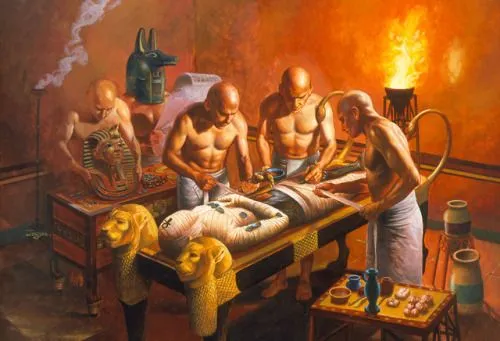
Entre cada capa de vendaje, se aplicaba resina para proteger el cuerpo de la humedad y mantener las vendas unidas.
Resin was applied between each layer of bandage to protect the body from moisture and hold the bandages together.
Finalmente se le colocaba a la momia una máscara funeraria que podía variar según la procedencia política y social del fallecido, y se colocaba a la momia en una suhet, es decir, un ataúd con forma humana. El sacerdote con la máscara de Anubis colocaba los símbolos sagrados sobre el ataúd y por último sellaban la tumba hasta la otra vida, aunque los saqueadores y arqueólogos las encontraron para perturbar su descanso.
Finally, a funerary mask was placed on the mummy that could vary according to the political and social origin of the deceased and the mummy was placed in a suhet, that is, a coffin with a human shape. The priest with the mask of Anubis places the sacred symbols on the coffin and finally they seal the tomb until the afterlife. Although looters and archaeologists found them to disturb their rest.
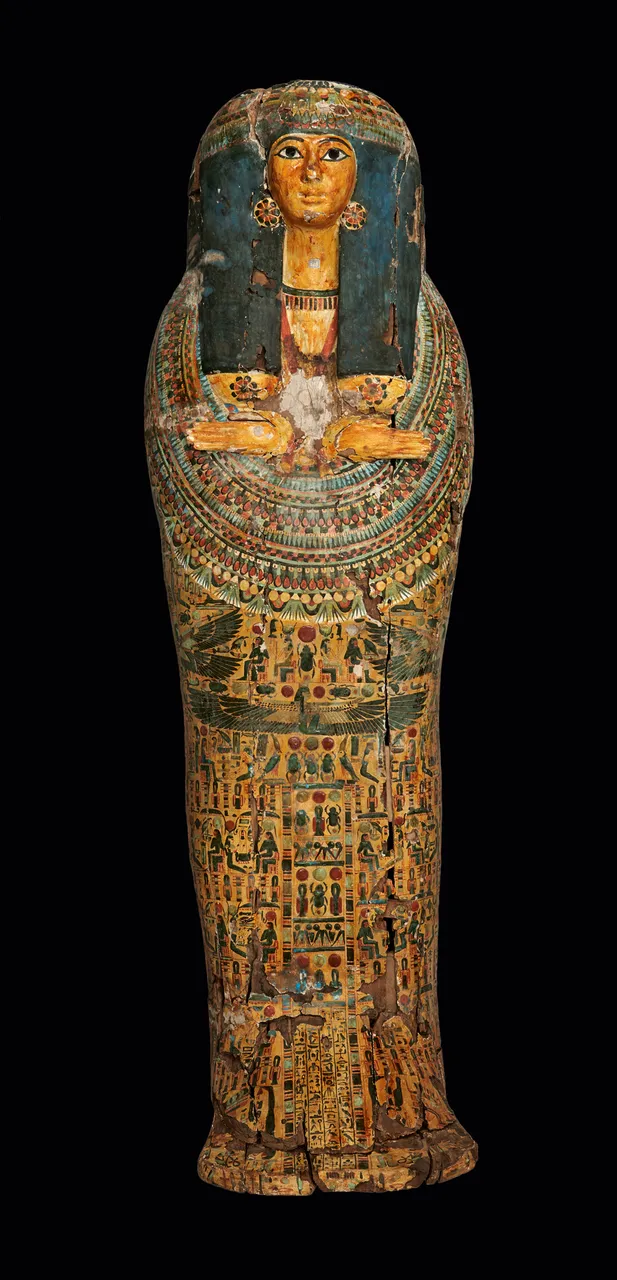
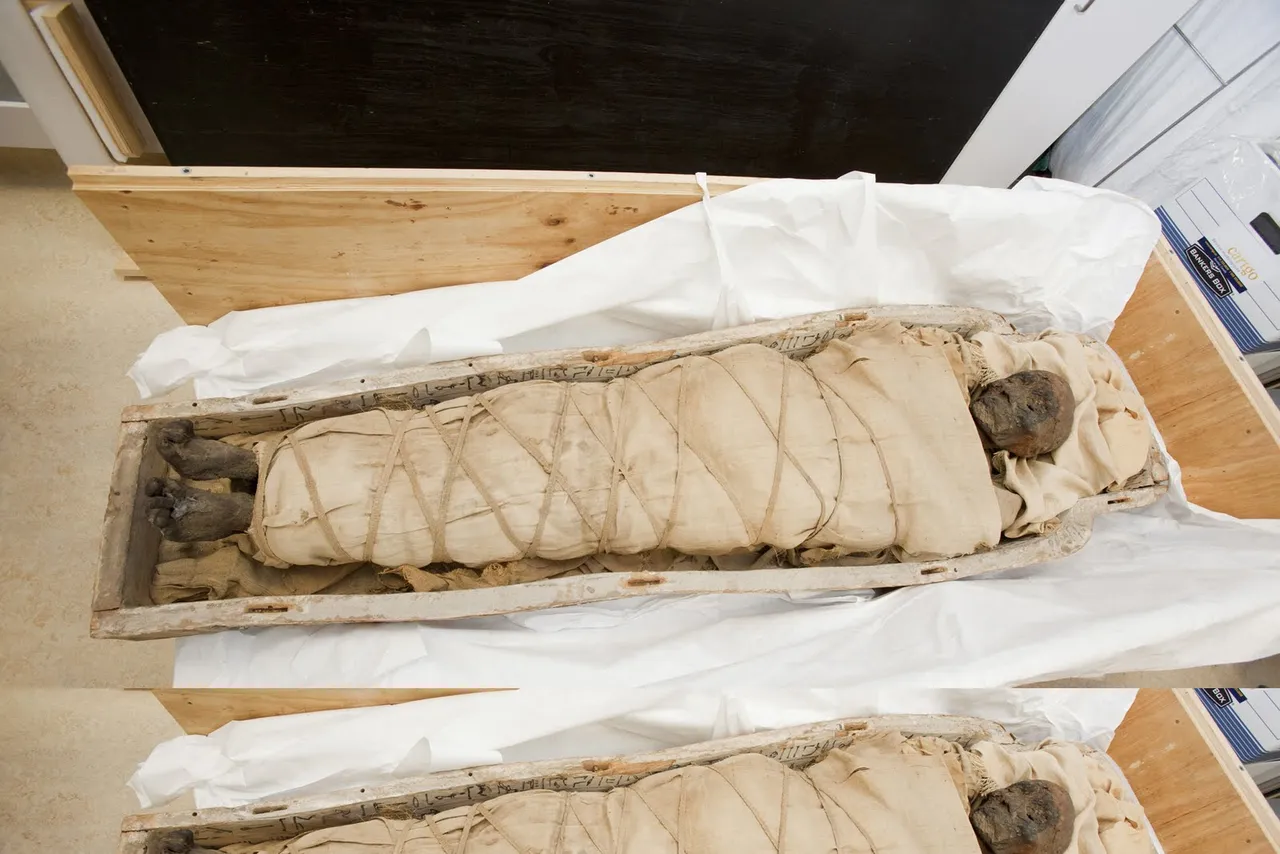

Las momias egipcias más famosas/
The most famous Egyptian mummies
Tutmosis IV
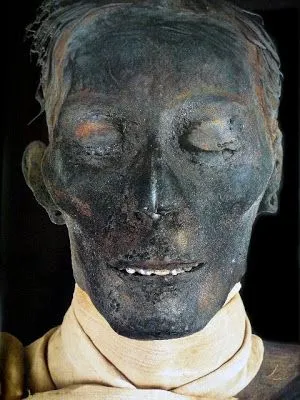
Tutmosis IV fue uno de los hijos del faraón Amenofis II. Reinó entre los años 1400 a 1390 a. C. Tutmosis aseguró que el dios Ra le dijo que él sería rey si lograba desenterrar a la esfinge que permanecía bajo las arenas desde hacía varios siglos. Se cree que murió entre 1391 a 1388 a.C, y su momia fue encontrada en 1898. Como pueden observar, su momia está muy bien conservada.
Tuthmosis IV was one of the sons of Pharaoh Amenophis II. He reigned between the years 1400 to 1390 a. C. Tuthmosis assured that the god Ra told him that he would be king if he managed to unearth the sphinx that had been under the sands for several centuries. It is believed that he died between 1391 to 1388 BC, and his mummy was found in 1898. As you can see, his mummy is very well preserved.
Ramsés II
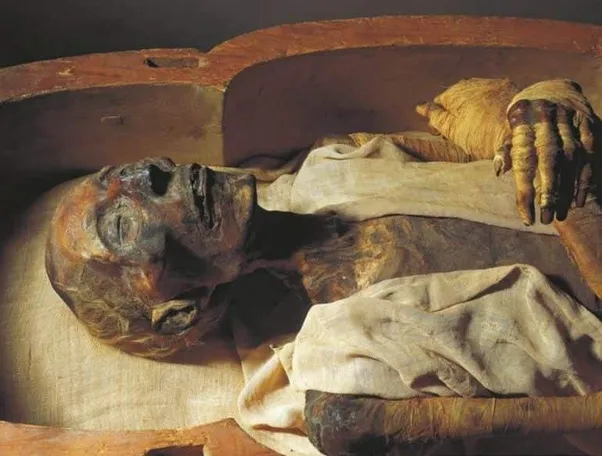
Es el tercer faraón de la Dinastía XIX, es uno de los faraones más célebres de Egipto, debido a todos los vestigios que todavía perduran de su período de reinado.
He is the third pharaoh of the XIX Dynasty, he is one of the most famous pharaohs of Egypt due to all the vestiges that still remain from his reign period.
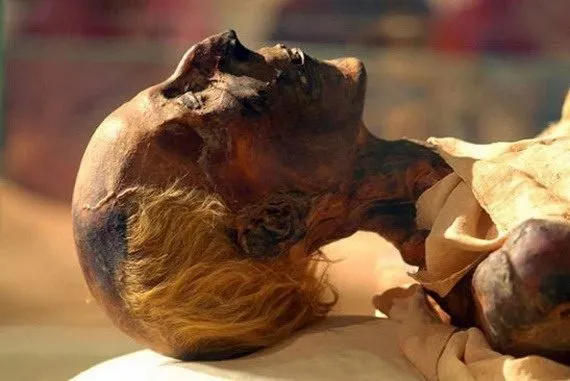
Su momia se considera como la mejor conservada en el mundo. En 1976 fue trasladada a Francia para someterla a una radioesterilización con rayos gamma que evitarían que los hongos la destruyeran.
His mummy is considered the best preserved in the world. In 1976 it was transferred to France to undergo gamma-ray radio sterilization that would prevent fungi from destroying it.
Aunque suene absurdo, la momia cuenta con un pasaporte egipcio, ya que las leyes francesas exigen que toda persona que entre al país (viva o muerta) debe tener uno.
Although it sounds absurd, the mummy has an Egyptian passport, since French laws require that everyone who enters the country (alive or dead) must have one
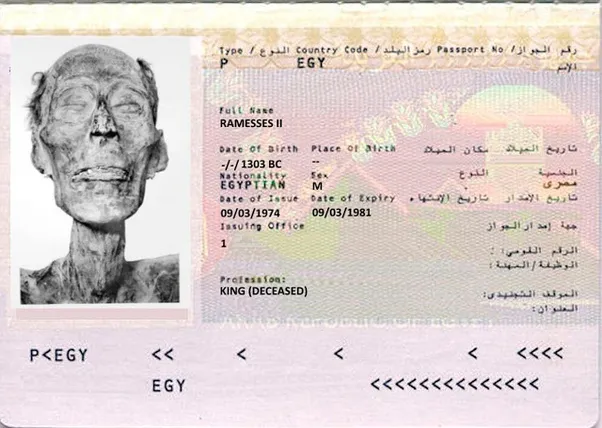
La Reina Tiye/The queen Tiye

Ella era la abuela de Tutankamón y fue considerada como una de las mujeres más influyentes de Egipto. Tenía muchos santuarios erigidos en su nombre, así como su propio lago artificial. Su momia fue descubierta en 1898 por el egiptologo Víctor Loretin.
She was the grandmother of Tutankhamun and was considered one of the most influential women in Egypt. She had many shrines erected in her name, as well as her own man-made lake. Her mummy was discovered in 1898 by the Egyptologist Victor Loretin.
Tutankamón
Finalmente llegamos a la más famosa de todas las momias, Tutankamón, también conocido como «El niño rey» debido a que no había alcanzado la adultez cuando llegó al trono. Su momia fue descubierta en 1922 por el egiptólogo británico, Howard Carter.
Finally we come to the most famous of all mummies, Tutankhamun, also known as "The Boy King" because he had not reached adulthood when he came to the throne. His mummy was discovered in 1922 by the British Egyptologist, Howard Carter.
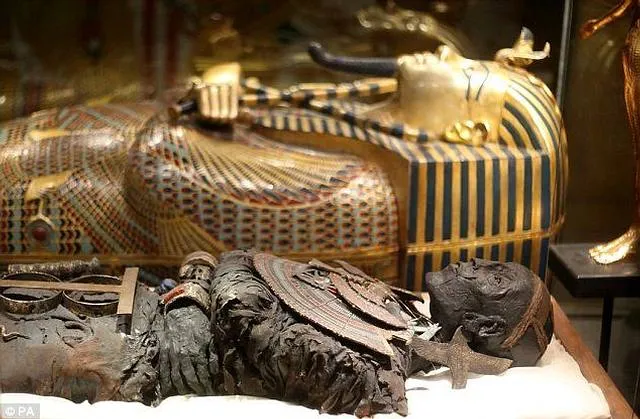
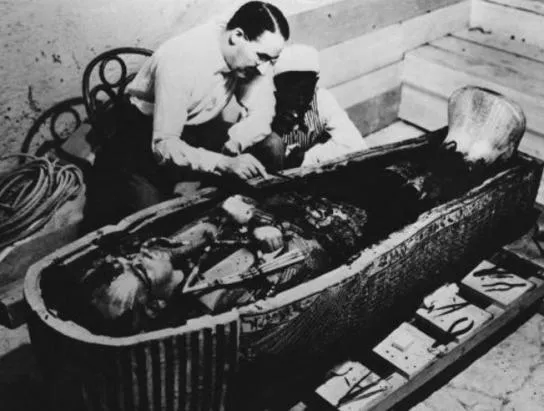

¿Qué te pareció este viaje al antiguo Egipto? A mí me encanta este tema desde que estudiaba Historia Universal en la escuela secundaria, me parece muy interesante, sin embargo, en mi opinión personal, creo que independientemente del valor arquealógico que tienen actualmente las momias, ellas deberían permanecer dentro de sus tumbas y no en el museo de El Cairo, ya que ése era su lugar originalmente ¿Qué opinas tú al respecto?
What did you think of this trip to ancient Egypt? I love this topic since I was studying Universal History in high school, I find it very interesting, however, in my personal opinion, I think that regardless of the archaeological value that mummies currently have, they should remain inside their tombs and not in the Cairo museum, since that was its place originally. What do you think about it?
Bueno amigos, hemos llegado al final de este artículo, espero que les haya gustado. Déjenme saber en los comentarios si les gustaría conocer más acerca del fascinante mundo del antiguo Egipto, de sus reyes más celebres, como era su vida cotidiana, en fin, todo lo que implica esa época. Muchas gracias por su atención, hasta la próxima.
Well friends, we have reached the end of this article, I hope you liked it. Let me know in the comments if you would like to know more about the fascinating world of ancient Egypt, its most famous kings, what their daily life was like, in short, everything that that time implies. Thank you very much for your attention, until next time.
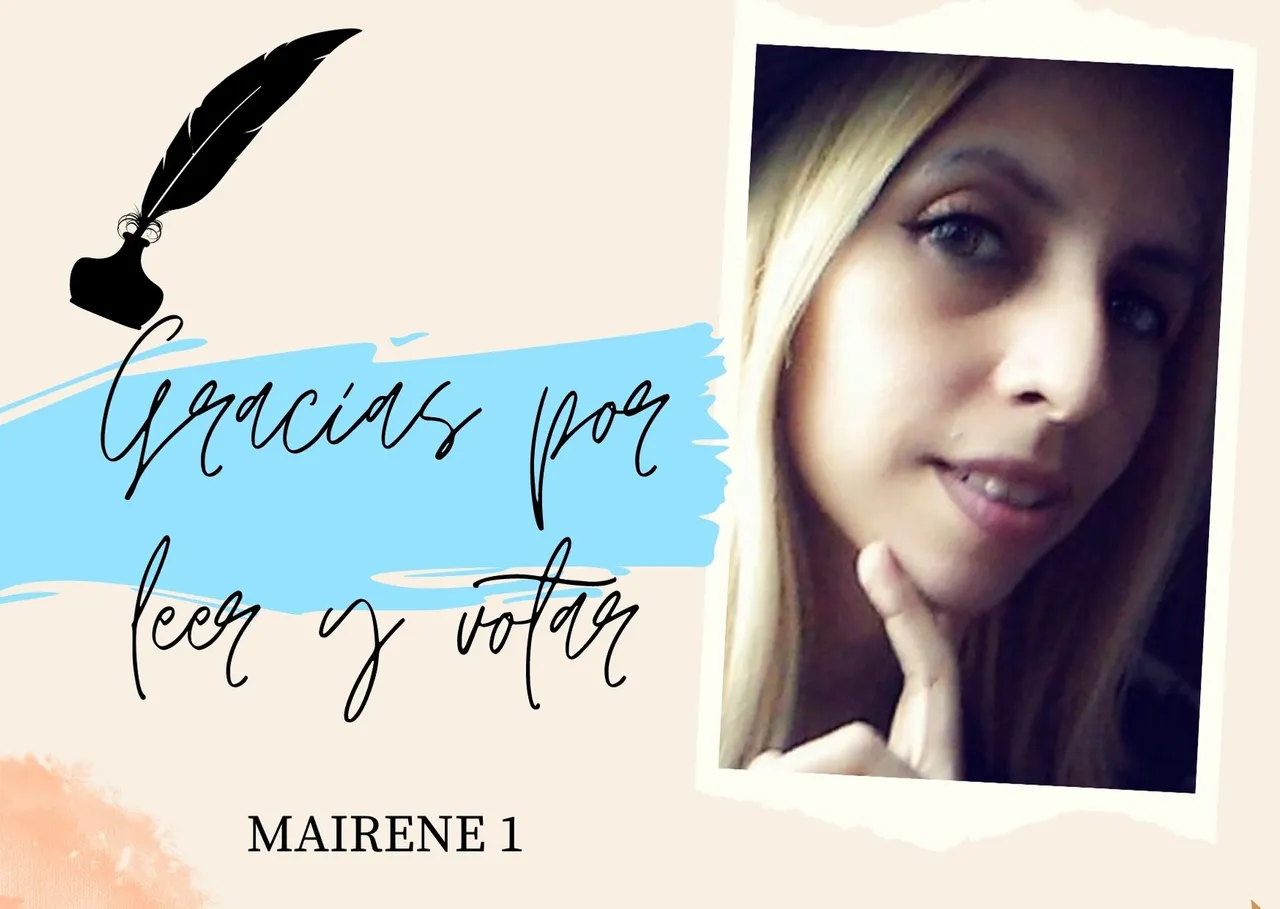
Thaks for reading and vote!
La imagen de portada, la de despedida y el separador de texto que usé fueron diseñados por mí, usando el editor de Canva.
The cover image, the goodbye image and the text separator I used were designed by me, using the Canva editor.